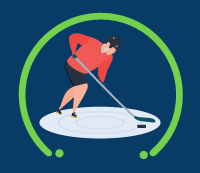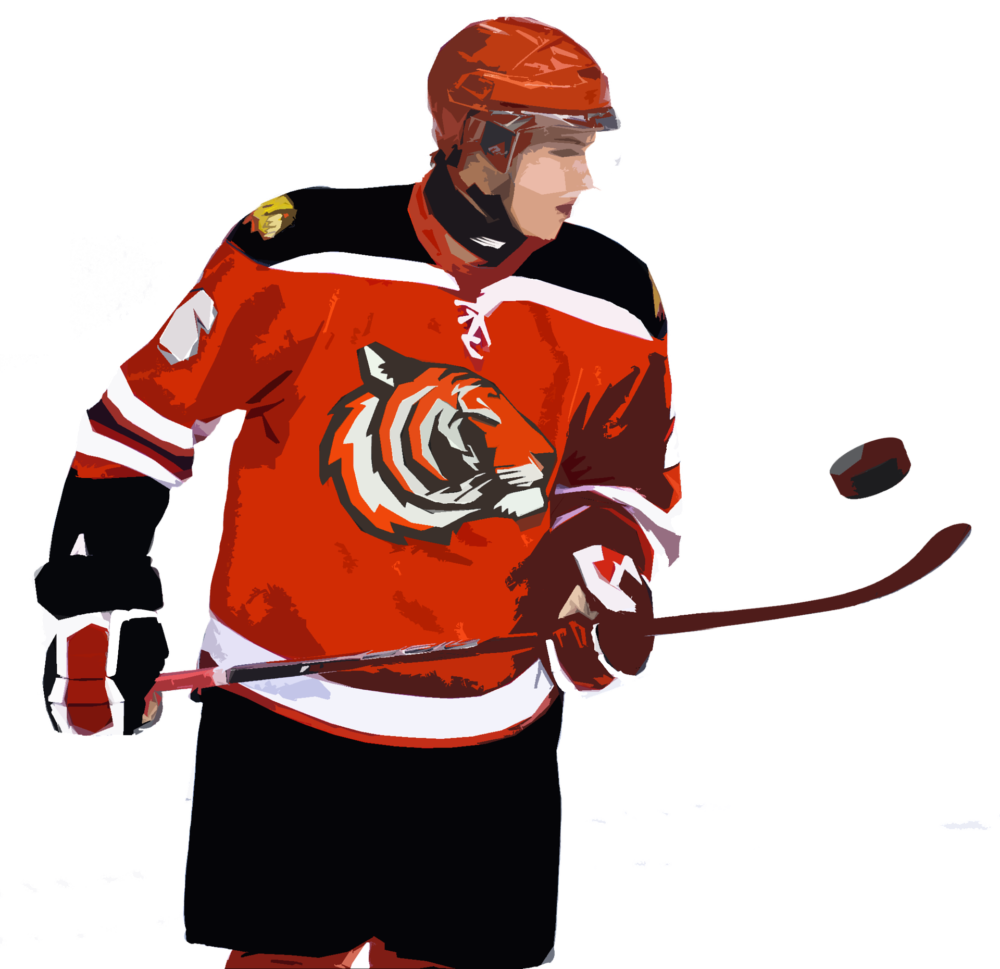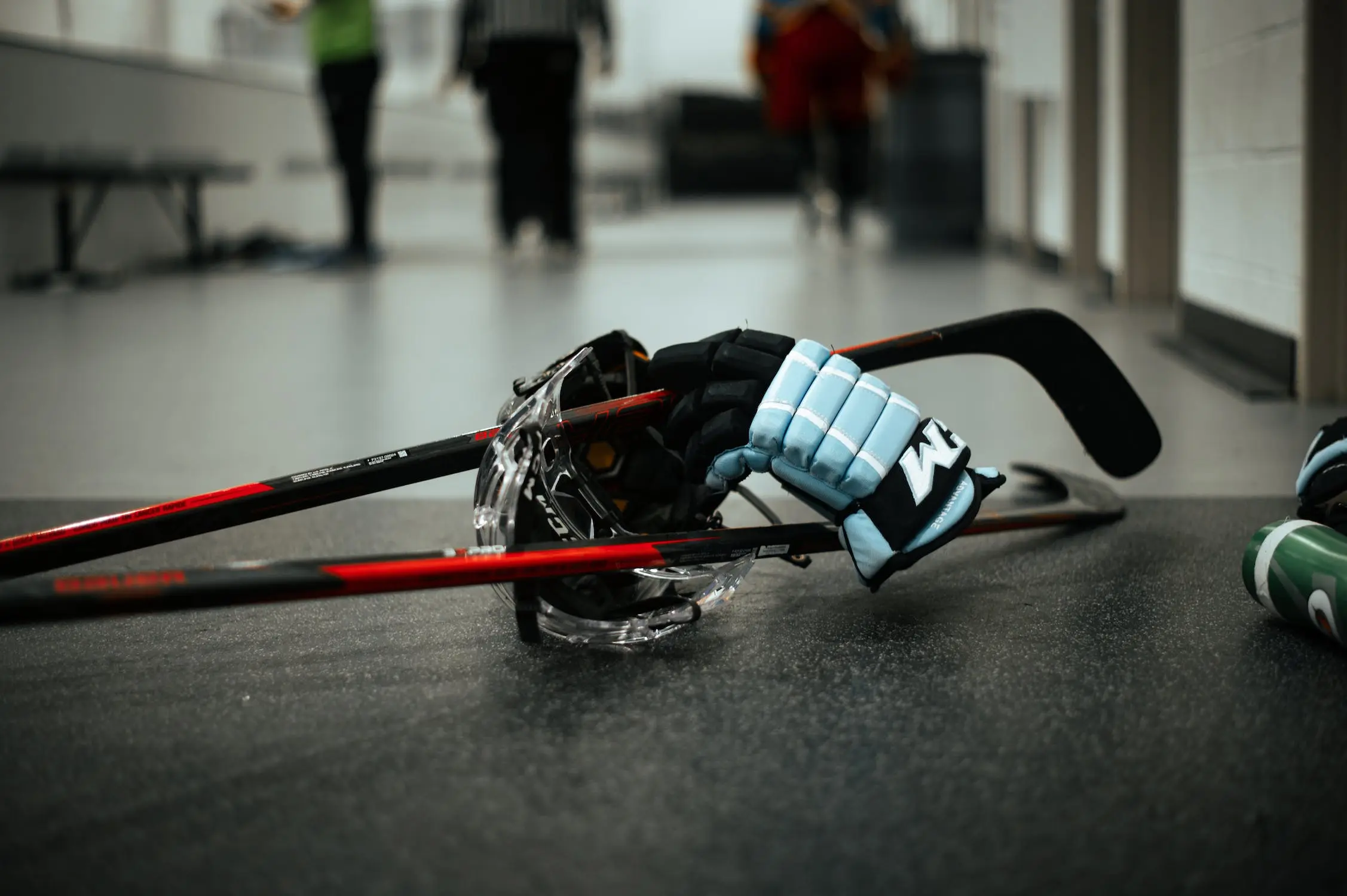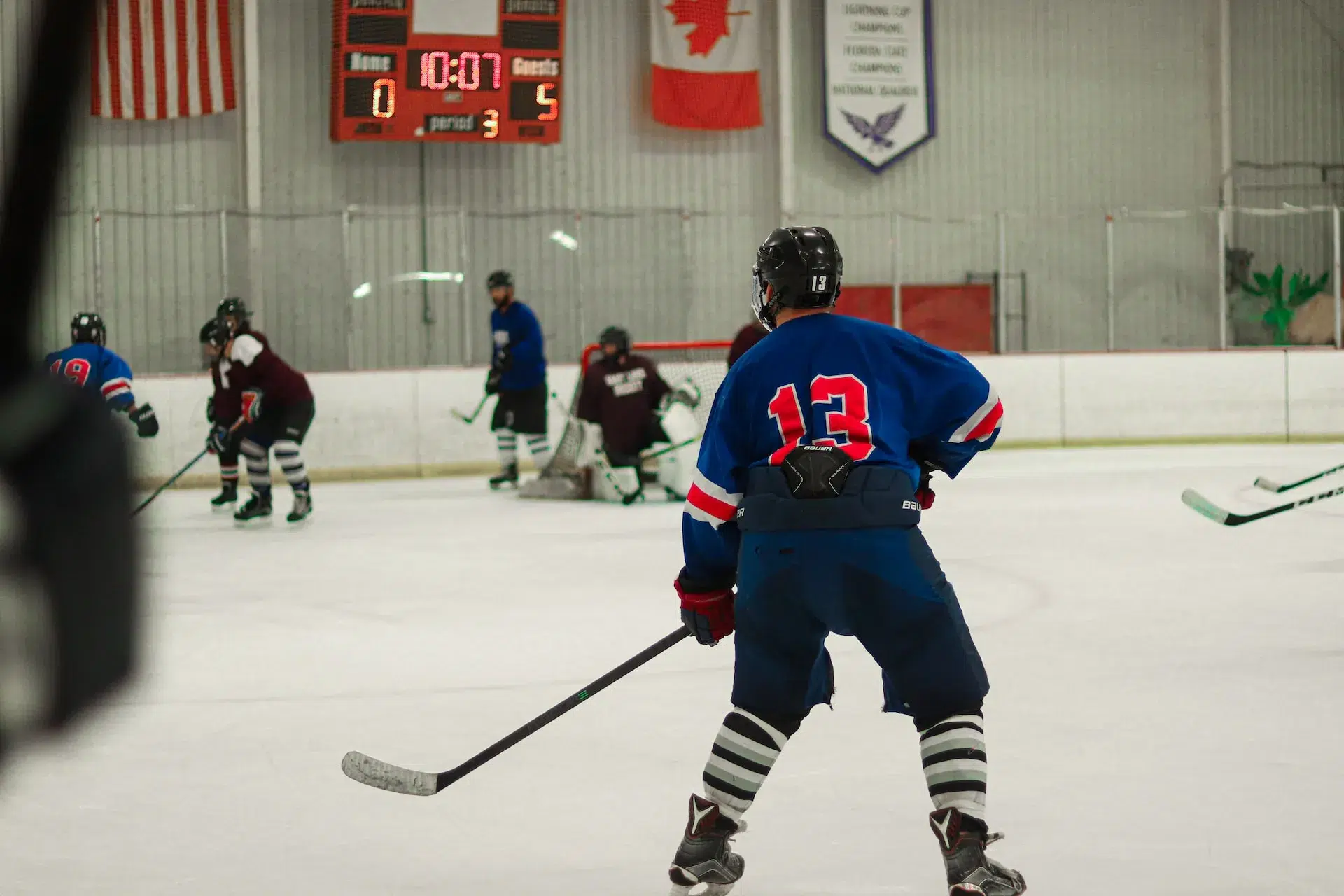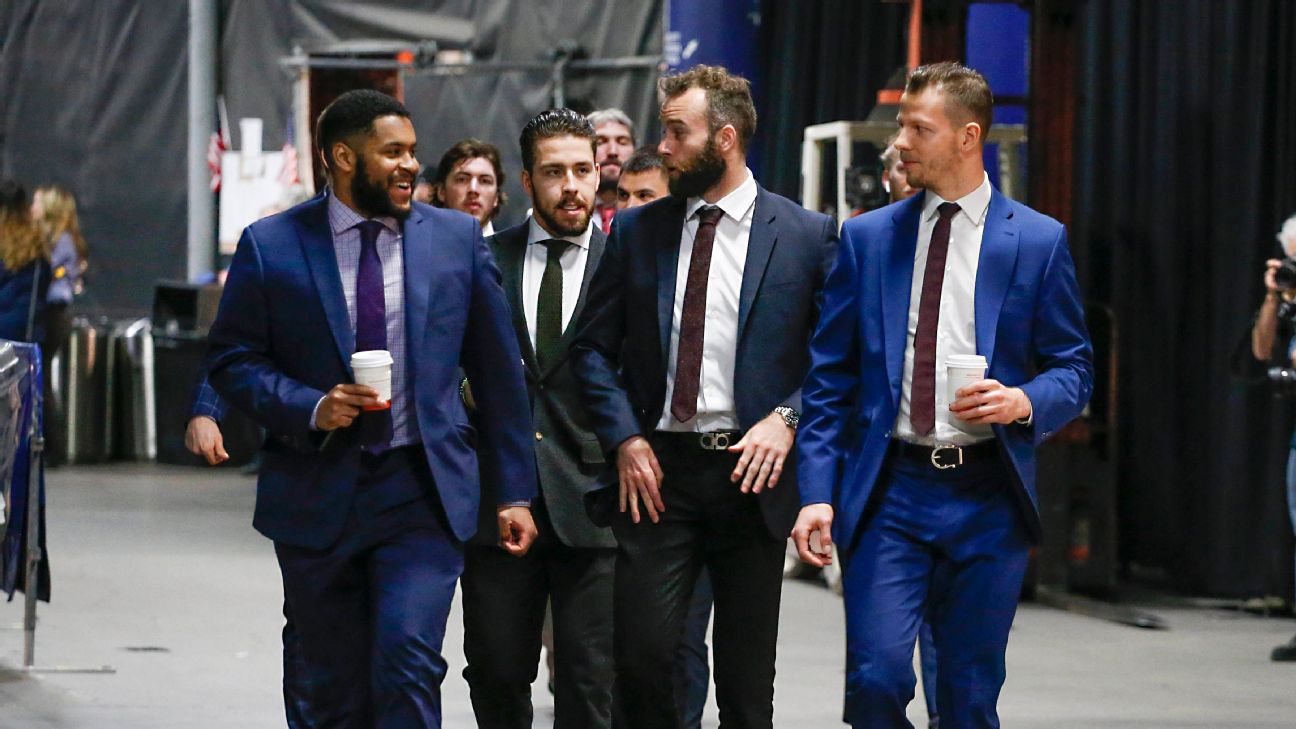Even after knowing about the various rules of Ice hockey and different ways of shooting or dribbling the puck, still you can’t play hockey until you have the proper equipment. There is so much equipment that is required for playing hockey by the players and goalie for ensuring their safety during the play. The players are encouraged to protect their bodies against bruises and severe fractures.
Besides hockey sticks and skates, players are equipped with an array of safety gear to lessen the risk to their safety. Today I will let you know about various equipment that you will need as a player and as a goalie.
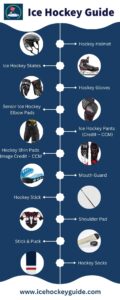
Guys, hold up before you dive into this post! I have created something that will greatly improve your reading experience. Look out for the gorgeous table I made just for you below. It’s the ultimate cheat sheet for understanding the equipment each player utilizes and what’s a must-have vs a nice-to-have or you can say is optional.
Ice Hockey Equipment Requirements by Player Type
| Equipment | Player Type | Mandatory or Optional |
|---|---|---|
| Helmet | All Players | Mandatory |
| Neck Guard | All Players | Mandatory |
| Shoulder Pads | All Players | Mandatory |
| Elbow Pads | All Players | Mandatory |
| Hockey Jersey | All Players | Mandatory |
| Hockey Gloves | All Players | Mandatory |
| Hockey Pants | All Players | Mandatory |
| Jockstrap/Pelvic Protector | All Players | Mandatory |
| Garter | All Players | Optional |
| Shin Guards | All Players | Mandatory |
| Hockey Socks | All Players | Mandatory |
| Mouth guard | All Players | Mandatory |
| Ice Skates | All Players | Mandatory |
| Hockey Puck | All Players | Mandatory |
| Hockey Stick | All Players | Mandatory |
| Goalie Stick | Goalies | Optional |
| Goalie Skates | Goalies | Optional |
| Goalie Mask/Helmet | Goalies | Mandatory |
| Chest & Arm Protector | Goalies | Mandatory |
| Blocker | Goalies | Mandatory |
| Catch Glove/Trapper | Goalies | Mandatory |
| Goal Jock/Jill | Goalies | Mandatory |
| Goalie Pads | Goalies | Mandatory |
| Socks | All Players | Mandatory |
| Mouthpiece | All Players | Mandatory |
| Visor/Facemask | All Players | Mandatory |
| Ear Guards | All Players | Optional |
| Throat Guard | All Players | Optional |
| Skate Guards | All Players | Optional |
| Stick Wax | All Players | Optional |
Equipment used by Regular Players (Center Forwards, Wingers & Defenders)
Helmet
A helmet is very important as it protects your face and head from injuries. When you are learning hockey, there are chances that you might fall more, so buy a good helmet so that you get good protection. All the players need a helmet with a strap and optionally a face visor cage is required by all the players.
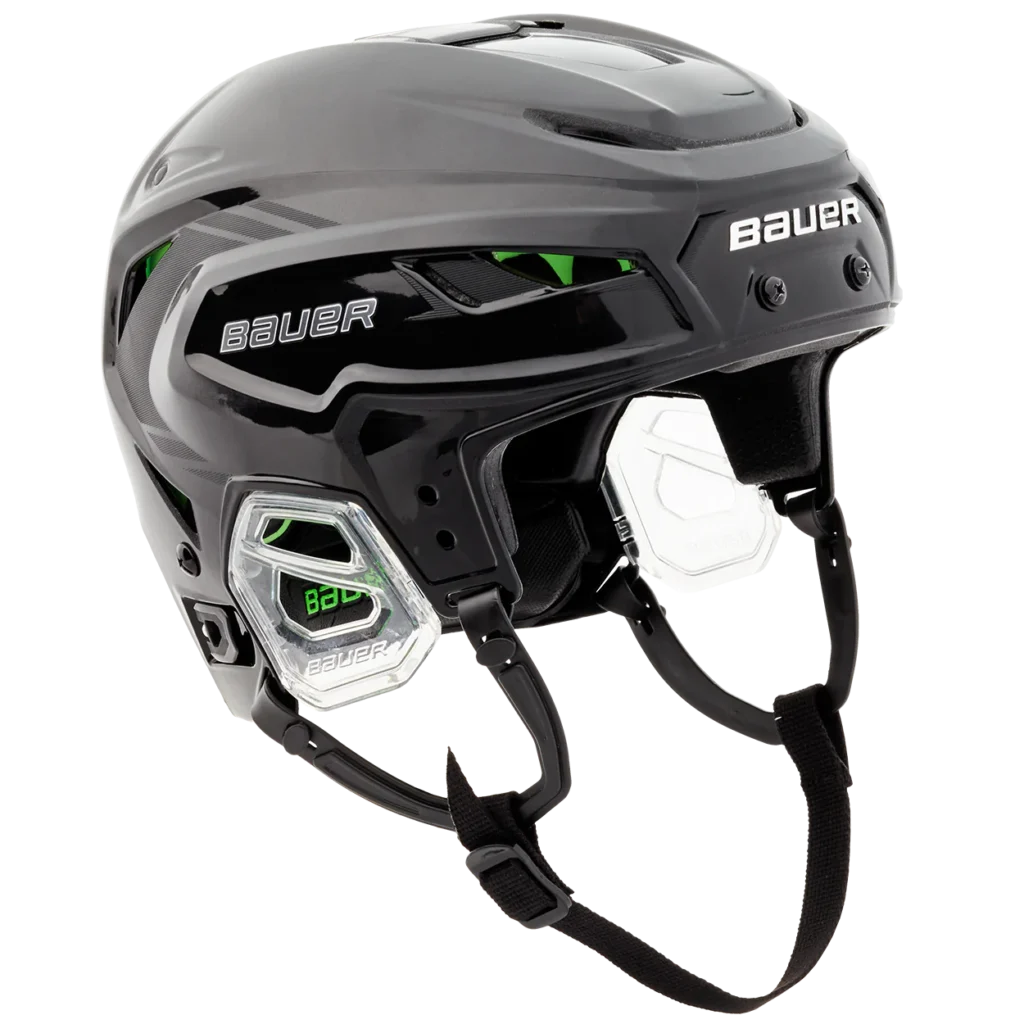
The hockey helmets come in different types and designs, and even the older versions can be adjusted by loosening or fastening the screws at the back or the side. These helmets are made of a rigid yet flexible thermoplastic outer shell, usually ABS or nylon. It has the inside padding of firm vinyl foam for reducing shocks. Even with the helmets and cage/visors injuries are common in this sport.
Your hockey helmet is arguably the most crucial piece of equipment you’ll wear on the ice. Don’t compromise on safety – use our guides on buying a hockey helmet and exploring Hockey Helmet Brands to find the best one for your needs, and stay protected during play.
Neck Guard
This gear is meant for the protection of your neck. For players usually, the neck guard is made of a series of plates of ABS or nylon for puncture resistance along with padding for comfort fitting. The outer covering consists of tear-resistant nylon mesh.
For goalies, their neck protector consists of a curved panel of clear Lexan and it hangs underneath the mask of iron cords. Both have been intended to reduce the impact of neck injury or throat by a skate blade or puck.
Shoulder Pads
Most leagues are noncontact and many don’t even allow slapshots. Due to this reason only shoulder pads are not required in a lot of leagues. These are omitted in practice sessions but virtually worn during games. The shoulder pads consist of a padded vest at the front and back panels with Velcro straps at closure along with soft or hard shoulder caps with optional upper arm pads.
These pads protect the chest, ribs, shoulders, spine, and solar plexus against collisions with other players on the ice and flying pucks.
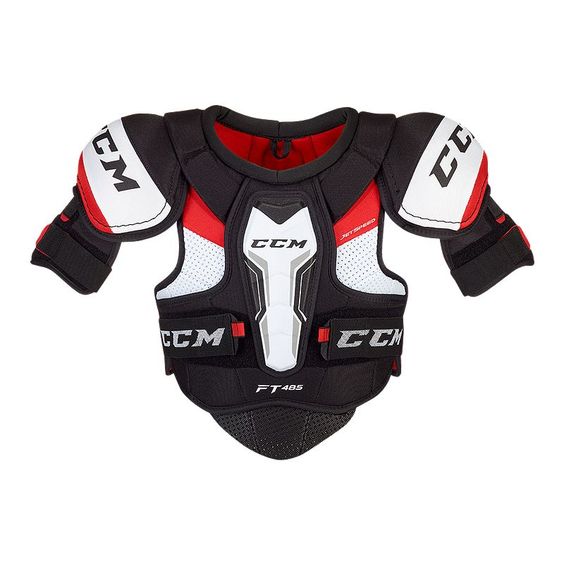
Elbow Pads
These protect the forearm and sometimes the triceps against pucks along with an elbow cup. These are compulsory for all the players. They protect elbow joints and arm bones from bruises and fractures. The elbow pads cover the elbow joint and part of the upper & lower arms. Some elbow pads come with extensions that covered the entire upper arm. Most elbow pads are adjustable and secured with Velcro straps.

Hockey Jersey
It covers the elbow pads and shoulders. Jerseys are color-coded, numbered for the team, and player identification. The upper-skill levels teams might have multiple jersey styles for away and home games. Traditional jerseys are roughly square, oversized, and made with fabrics having limited elasticity.
A fight strap is required for connecting the jersey with the inside of the pants along with protecting the pulling of the jersey by other players during the game. Today’s jerseys are made of more elastic fabrics so are more form-fitting and resemble NFL jerseys in the overall fitting.
Hockey Gloves
These are for hand protection and are constructed with very thin leather fingers and palms along with providing more padding to the outside of the hands. Besides this, they also reinforce the thumbs to prevent them from bending backward.
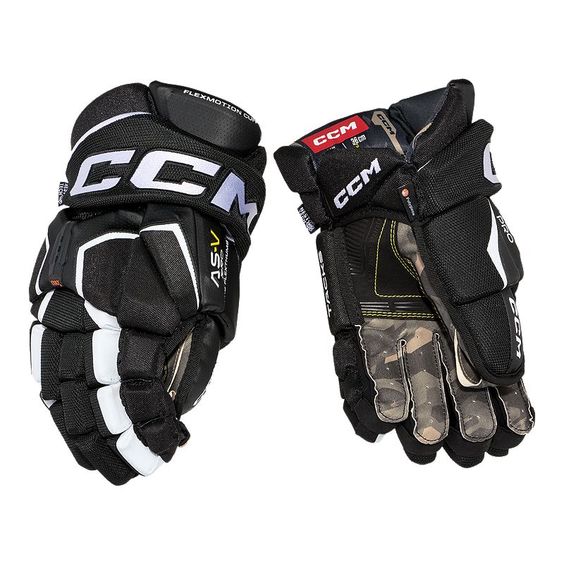
Hockey Pants
These are knee-length oversized shorts consisting of pelvic, tailbone, hip, and thigh pads and they clinch at the waist. Suspenders or belts are required for holding the hockey pants.
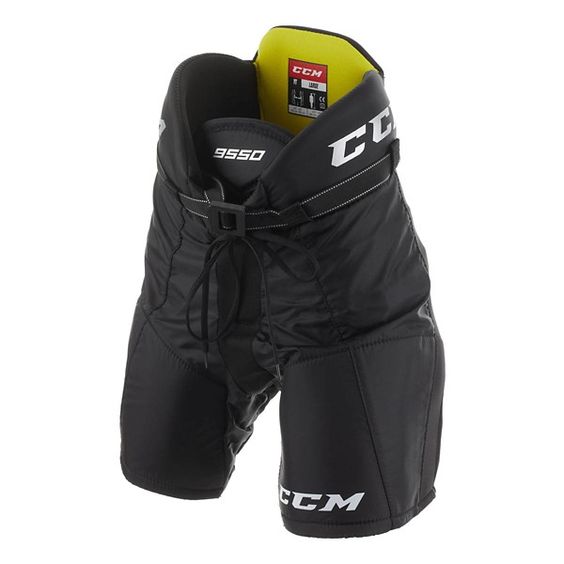
Jockstrap or ladies’ pelvic protector
The jock is a protective cup designed for protecting the genitals. This cup easily fits into a trap or sports support. Some jockstraps come designed with inbuilt garter belts so that long socks can be worn. Many companies have jock shorts incorporated with jock straps into a pair of athletic shorts, boxers, or into elastic shorts that enhance the garment’s coverage and help in positioning the cup securely against the anatomy of the player without shifting. Other similar garments like pelvic protectors or jill straps also provide a hard shell protecting the female genitalia along with the lower pelvis from any impact.
Garter
For holding up hockey socks, garter belts are often used by players. A garter is nothing but an elastic band that goes around the waist and comes with various straps that go down to the front and back of the leg. At the end of each, there is a hook or clip that attaches to the sock. The newer version of garter belts comes with velcro straps that make attaching to the socks easily. How many jock shorts and hockey pants come with built-in garters in the form of Velcro patches on the front & back for grabbing the socks.
Shin Guards
Shin guards in hockey are different from those used in soccer. Shin guards in ice hockey must cover the entire ankle up to the bottom of the kneecaps of the athlete. While playing hockey, the shins take maximum eating from the sticks and pucks.
These guards come with hard plastic shells from outside and on the front for protecting against pucks. But these have either no or little protection on the calf. Shin guards help protect the frontal bones of the legs and knee joints from pucks, skates, sticks, falls, and other impacts.
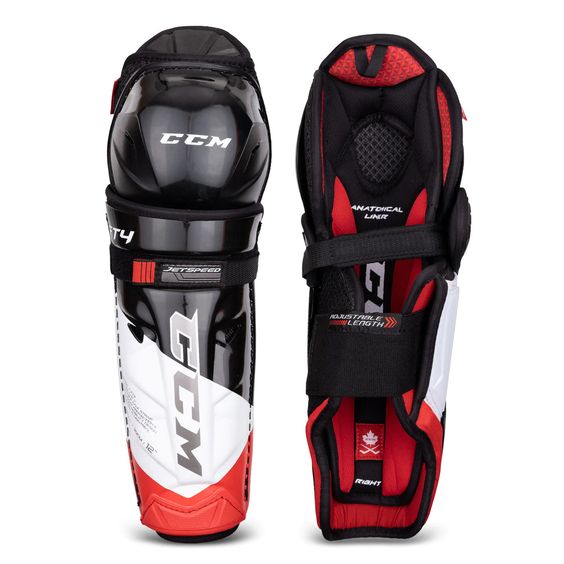
Shin guards must be of the proper size for getting the proper protection. If it is too long then it will slip down into the skate and prevent the proper movement of the ankle. If it will not fit into the knee joint, then it will not be able to protect the patella and will lead to an injury. There is a size chart for shin guards available at all stores which must be followed by every player to get access to the accurate size.
Hockey Socks
The traditional hockey socks are knitted wool or synthetic tube stocking without a foot. As per the USA hockey rules, socks are an important part of the team uniform and must be worn with the jersey covering the shin guards.
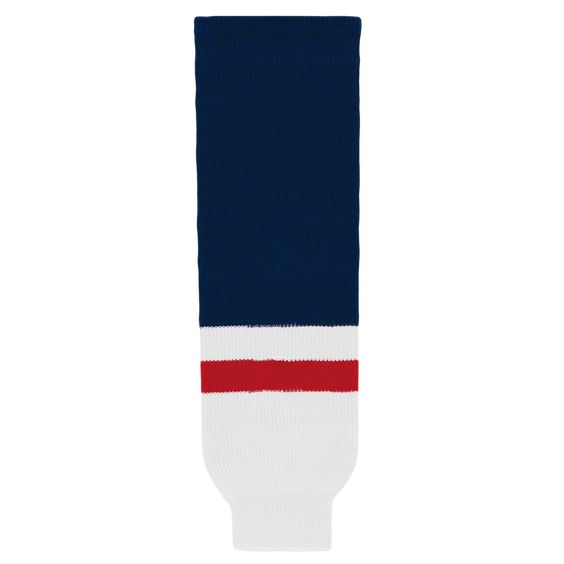
Mouth guard
Even though hockey is a contact sport, wearing a mouthguard is compulsory while playing the game. It comes in different variants from plastic guards to custom moldable boil & bite compounds that also make speaking easier. In the past few days, hockey players have missed their front teeth and this was because of no protection for teeth. But today most players wear the mouth guard for protecting their teeth and jaw from blows and fractures.

Ice Skates
Hockey skates consist of a rigid shell, foam fitting to the foot of the player using memory foam, and heat moldable components reinforced with metal mesh for preventing the skate blade from cutting through. These skates have no toe picks and come with rounded heels. Ice skates are necessary for all players and they come in various sizes & styles. The important component of all hockey skates is an interior boot, the attachable blade, and the exterior holder. Most skates also come with rigid toe caps and heel ridge protectors. Usually, the tongue of the skates must end at or above the starting of the shin guards.
When choosing your ice hockey equipment, knowing the distinctions between hockey skates and figure skates is crucial. Dive into our in-depth guide on Hockey Skates vs. Figure Skates to make confident decisions that align with your playing style and needs.
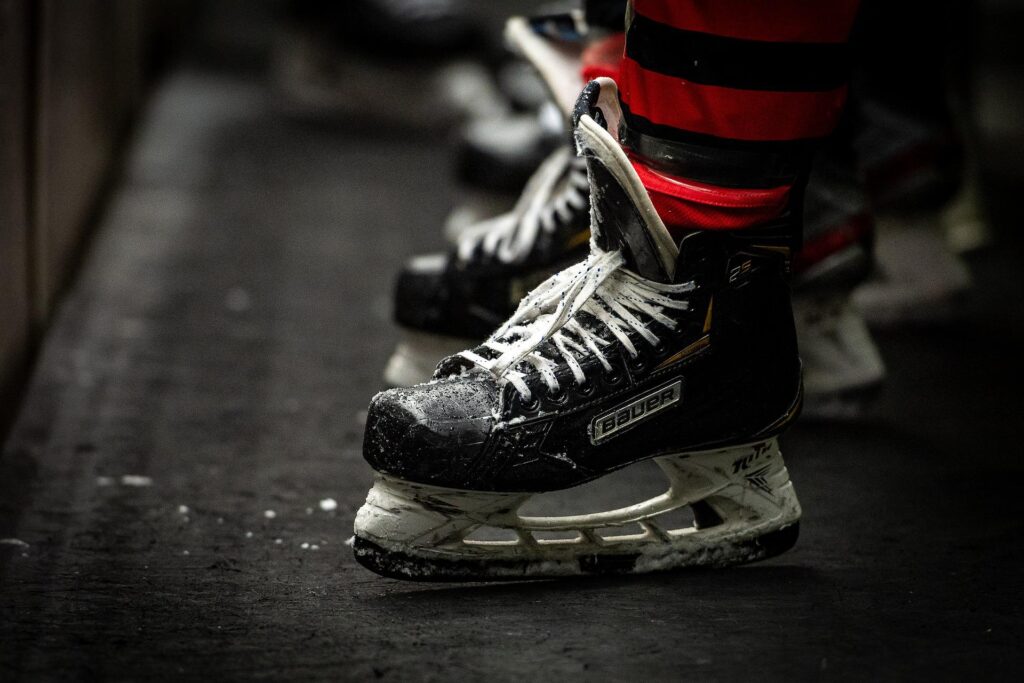
Hockey puck
The standard hockey puck has a 3-inch diameter, 1-inch thick, 6-ounce vulcanized rubber disk. The control of the puck determines the outcome of this game.
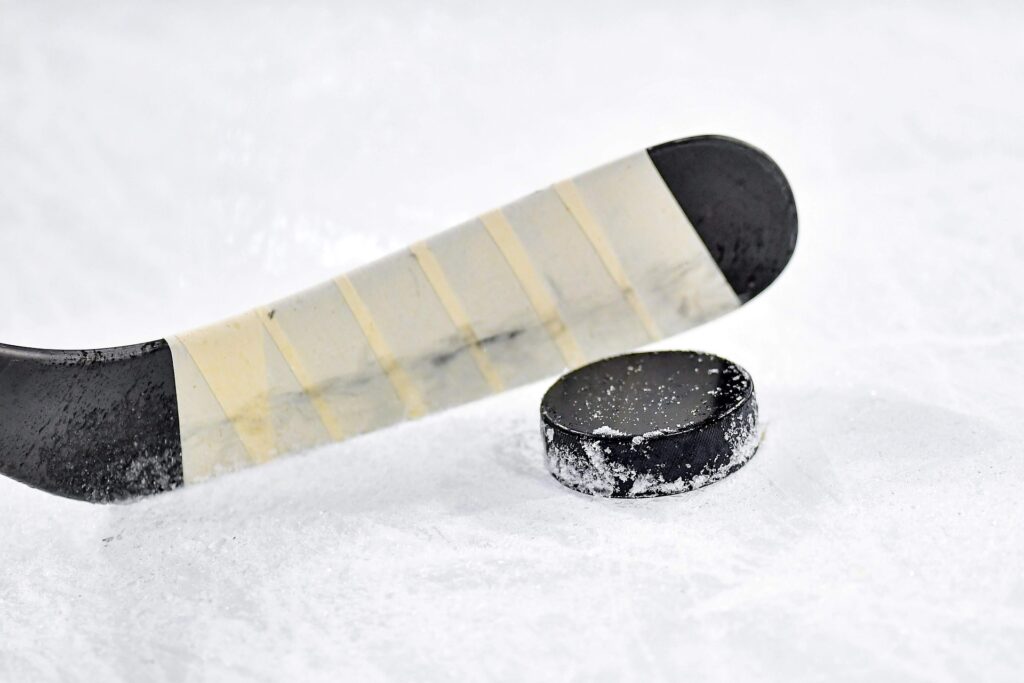
Hockey Stick
Hockey is made up of composite, fiberglass, or wood materials and comes in different styles and lengths. The size dimensions vary as it is dependent on the size of the player. Traditionally, all the sticks were wooden until the late 1990s as wood is inexpensive and tough. The features of all sticks will subtly vary from each other due to changes in the grain structure. Before breaking they also allow less flex.
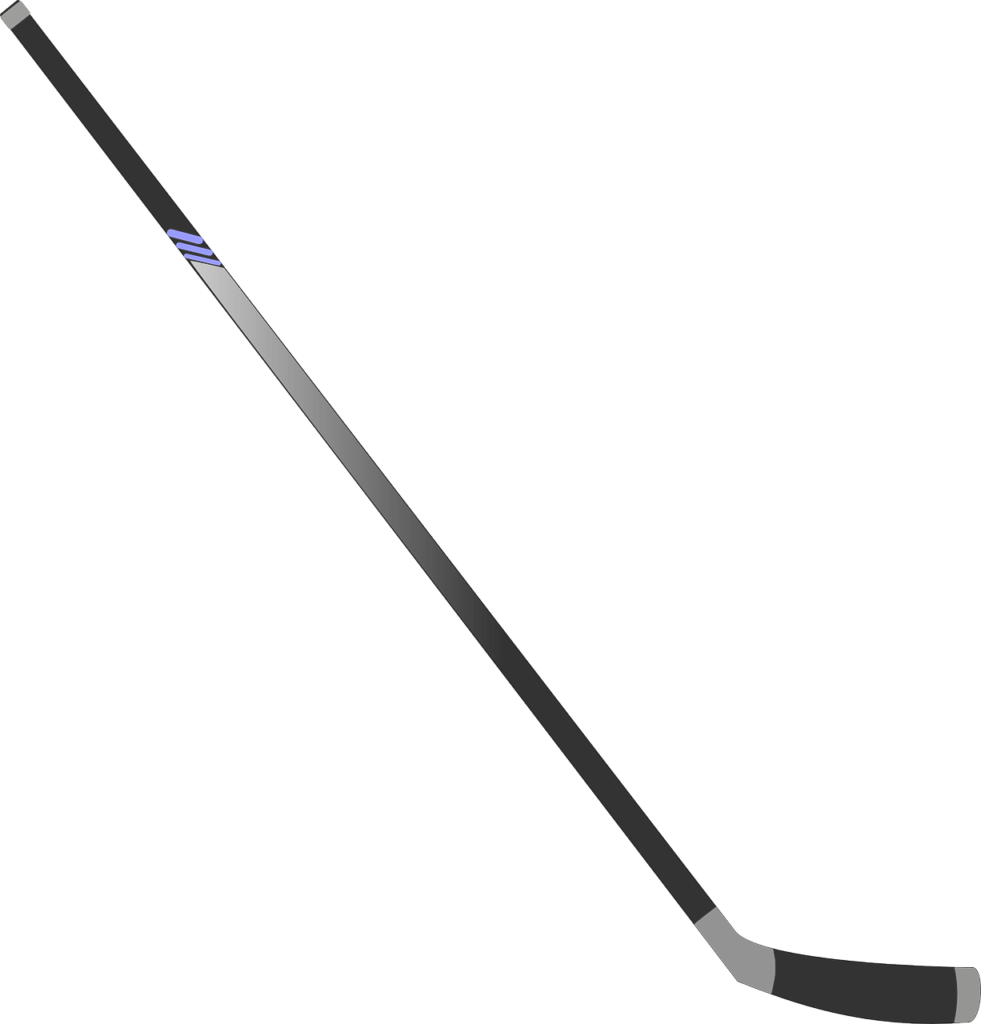
The most advanced hockey sticks are made up of graphite and manufactured with specific flex patterns that allow more accuracy and power while hitting the puck. But these benefits come with more cost and overall less durability. Graphite sticks have two varieties of one and two pieces. A two-piece stick composed of a shaft and blade allows greater customization along with the replacement of damaged shafts & blades without replacing the entire stick. Whereas one-piece sticks generally give better flex characteristics towards the bottom of the shaft, if the stick breaks or becomes unusable, then it is entirely discarded.
Check out my other article, The Ultimate Guide to Ice Hockey, for more information on the Ice Hockey.
Goaltending Equipment
Goalies get special variations on equipment for increasing their chances of stopping pucks and extra protection. Goalies get more protection from front impacts and less or no protection toward their back. Following is the gear that is required by the goalie in all the leagues to effectively perform their role in goaltending.
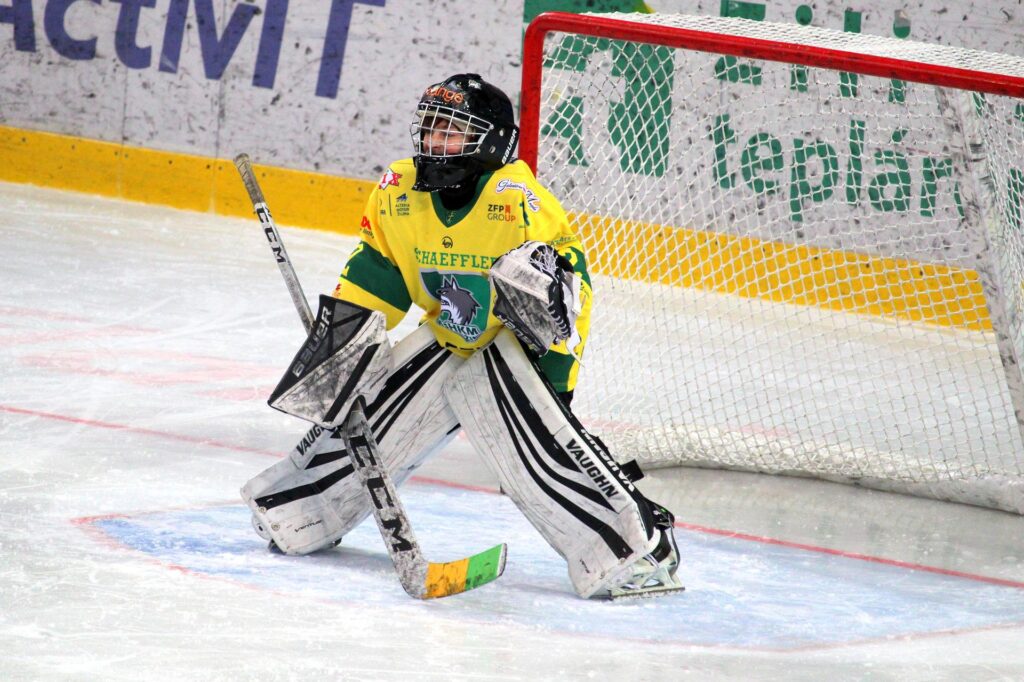
Goalie Stick
The goal stick comes with a larger lade than the sticks of players and a widened flat shaft. Virtually, these are always made up of wood for durability in comparison to the fiber construction of sticks of the players. For enhanced impact resistance goal sticks may have carbon-fiber or fiberglass panels on the shaft and blade. Mostly the stick is used to stop the puck, but the goalie can also play with it.

For helping in playing the puck, the blade might be curved. The length of the stick is comparatively shorter than player sticks for providing better coverage between the blocker and torso’s side when in a butterfly position, along with stopping the paddle when standing, thereby creating gaps between the paddle and the five-hole.
Goalie Skates
The goalie skates come with a thicker blade with a larger blade radius and less ankle support allowing the goalie to slide off their skates for making the pad stop more easily. The boot is closer to the ice surface in comparison to a regular hockey skate for preventing the pucks from slipping through the area between the skate blade and boot.
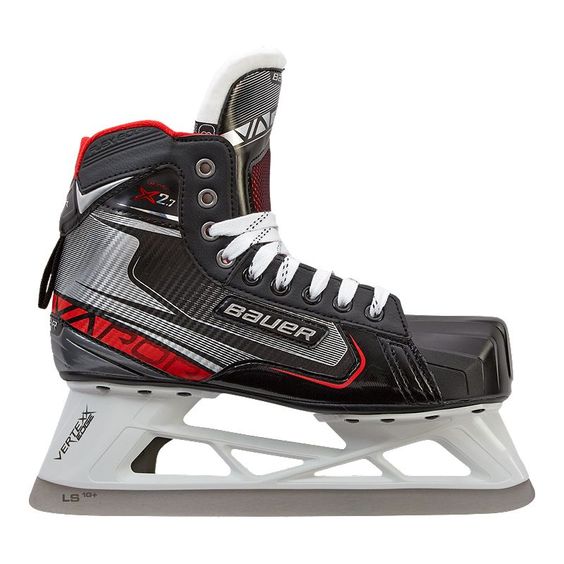
Goalie Mask or helmet and wire facemask
Masks are fitted to the face of the paler and can prevent them from several high-speed face impacts from pucks. Now, most of the leagues require that a goalie must wear a throat protector and a padded neck guard for protection against skate blades and pucks. Even the NHL has made it mandatory for all goalies after the famous incident where the jugular vein of goalie Clint Malarchuk was severed by the skate blades of the player Steve Tuttle during a game.

Chest & arm protector
The chest & arm protector is more thickly padded from the front side than the shoulder pads of the player which also incorporate the protection of the elbow, biceps, and forearm. The protective area extends down to the abdomen and for seamless protection, they are usually tied onto the pants. These offer very little back or spine protection for saving on material & weight and preventing heat buildup.
Blocker
This is worn on the hand that holds the stick. This is a glove with a rectangular pad at the back used for deflecting the shots. It has also gone through innovations which include a curved portion for redirecting the block pucks outward instead of back or up and the front portion has been specially shaped for allowing paddle-down saves where the hockey stick horizontally lies over the ice surface. Due to league rules, the blockers are limited in overall ice surface area.
Catch glove or trapper
It is worn on the opposite hand for gathering up the puck on the ice or stopping or catching the flying shots. A goalie has the right to freeze the play and force a faceoff by trapping or holding the puck in their catching glove or they also might catch & release the puck by catching & dropping it onto their stick or behind the net for playing it. By league rules, catches are also limited in the width of wrist padding and overall gloves circumference.
Goal jock or jill
Goal jock provides more padding in a front cup and better pelvic protection from the players’ jock. They also provide lower abdomen protection along with a stronger cup.
Goalie pads
These might be the most visible part of the goalie’s equipment. The legs of the goalie are thickly padded with flat forced leg pads that cover the top of the skate, shins, and knees along with incorporating the additional padding on the inside of the leg & knee for protecting the knee joints when dropping into a butterfly position. The pads are usually 11 or 12 inches wide but recent NHL rules have reduced the width of these pads and sized them to fit the legs of the player.
While exploring the essential hockey equipment, consider the significance of hockey net dimensions and their impact on the game, detailed in our specialized guide.
Socks
The socks of the goalie cover the leg from the foot to above the knee. Usually, this is the only protection given to the calves of the goalie as the cheaper pads have just a series of straps at the back, but the expensive goalie pads offer flexible flaps designed for protecting the calves.
To learn about key positions and roles of players in ice hockey, read my guide on Ice Hockey Positions.
Training Equipment
The training equipment is required to improve the skills of a hockey player like shooting skills, passing skills, and stick skills.
For Shooting Practices
The following equipment is used for improving shooting skills:
- Shooting targets
- Shooting radars
- Hockey stick weight
- Shooting tarp
- Indoor flooring tiles
- Hockey launchpad
For Passing Skills
The following equipment is required for improving passing skills:
- Hockey puck passer
- Puck catcher
- Indoor flooring tiles
- Hockey stick weight
The following equipment is required for improving the stick skills that help in enhancing the efficiency while carrying the puck:
- Stick-handling trainer
- Indoor flowering tiles
- Slide boards
- Stick-handling trainer ball
If you want to enhance your physical and mental abilities for ice hockey, take a look at my guide to off-ice hockey training. It covers everything from strength and speed to endurance and cognitive agility.
Notable brands
Following are the hockey brands that have the best hockey equipment to offer you:
- Bauer
- CCM
- Warrior
- True Hockey
- Sher-Wood
- STX
- Easton
- Graf
- Vaughn
- Mylec
- Winnwell
- Howies Hockey Tape
The Bottom Line
There is a lot of hockey equipment required for playing a hockey game. Though there are some of the most important pieces of equipment that are to buy as a minimum requirement of playing hockey like ice skates, gloves, pucks, helmets, and a hockey stick. Rest other protective equipment is dependent on the size and level of the game or competition that you are playing. As a goalie, you will need a helmet, neck protector, mask, goalie glove, blocker, and more padding for safety.
If you would ask me about the pricing of the equipment then it would depend on the number of pieces that you would buy and also the company from which you are buying. If you are buying used gear, then you can expect it to be less costly and if you are buying senior–level equipment from a store, then your spending must be very high. So, I would suggest comparing the prices and quality of all the popular stores and then decide from where to buy and how many pieces to buy.
What equipment do you need to play ice hockey?
Skates, a helmet with a cage or shield, shoulder padding, elbow pads, gloves, a cup, shin guards, and a stick are all essential. Many players also wear additional equipment like pants, socks, and a neck guard.
How do I know what size equipment to buy?
Most equipment is sized based on height and weight. You can typically find a size chart online or in-store that will help you determine the right size for each piece of equipment.
How much does ice hockey equipment cost?
The cost of equipment can vary greatly depending on the brand and quality of the equipment. A full set of equipment can cost anywhere from a few hundred to a few thousand dollars.
Can I rent equipment instead of buying it?
Yes, many local ice rinks and hockey businesses provide equipment rental programs, which might be an excellent choice if you need to rent equipment.
What should You look for when buying a hockey stick?
While buying a hockey stick, consider the flex, length, and curve of the blade. Flexibility should be proportional to size and strength, whereas length should be proportional to height. Note that the curve of the blade might affect shot accuracy and power.
What kind of skates should you buy?
When buying skates, you should consider the fit, support, and blade. Skates should fit snugly but not be too tight or uncomfortable. They should also provide enough support for your ankles. The blade should be sharp and appropriate for your skill level.
With so many options available, choosing the right hockey gear can be a complex task. Different brands offer unique features for both skates and sticks, and knowing the distinctions between them can greatly assist your decision-making process. Explore our comprehensive guides on Hockey Skate Brands and Hockey Stick Brands. Additionally, for in-depth insights on selecting skates, check out our guide on How to Buy Hockey Skates, to find the perfect fit for your needs and playing style.
How often should your equipment be replaced?
Depending on how regularly you use and maintain your equipment, its lifespan may change. Regularly check your equipment, and replace anything that appears worn or broken. Some equipment, like helmets, should be replaced every few years regardless of wear and tear.
How should you look after my equipment?
Dry out your equipment after each use and store it in a cold, dry place to extend its longevity. It should also be cleaned on a regular basis and inspected for signs of wear or damage. Gloves, for example, can be protected from drying out and cracking by applying a leather conditioner.
What’s the most important piece of equipment for a beginner?
A helmet with a cage or shield is the most critical piece of equipment for every hockey player. Almost every professional league demands this type of head and facial protection.
What type of skates is best for ice hockey beginners?
Beginners should use traditional ice hockey skates with give greater support and stability than recreational skates.
What type of helmet should You wear for ice hockey?
It is recommended to wear a certified ice hockey helmet with a cage or visor that provides full facial protection.
Can you use any type of gloves for ice hockey?
No, you cannot play ice hockey with any gloves. Only ice hockey gloves created exclusively for the sport should be used to protect your hands and enable movement while playing. Wearing gloves that are not designed for ice hockey can be hazardous and increase the chance of injury.
How often should I sharpen my ice hockey skates?
Sharpening your skates is recommended every 8-10 hours of use or if you feel they are not gripping the ice adequately.
Besides hockey sticks and skates, players are equipped with an array of safety gear to lessen the risk to their safety. Today I will let you know about various gear that you will need as a player and as a goalie.
Enhance Your Ice Hockey Skills: Skating Drills, Tips, Nutrition, and More!
Take your ice hockey game to the next level with our comprehensive resources. Improve your agility and speed with effective skating drills, gain a competitive edge with game-changing tips, optimize your performance with proper nutrition, and understand the strategic importance of icing in hockey.
- Ice Hockey Skating Drills: Enhance Your Agility and Speed
- Ice Hockey Tips: Gain a Competitive Edge on the Ice
- Ice Hockey Nutrition: Optimize Your Performance
- Icing in Hockey: Understand the Strategic Impact
- Hockey Clothing Brands
- Body Checking in Hockey
- Hockey Helmet Sizing and Fitting
Equip yourself with the knowledge and skills to excel on the ice. Enhance your skating, improve your gameplay, fuel your body, and grasp the strategic elements of icing in hockey. Stay tuned for more valuable content to support your ice hockey journey.
